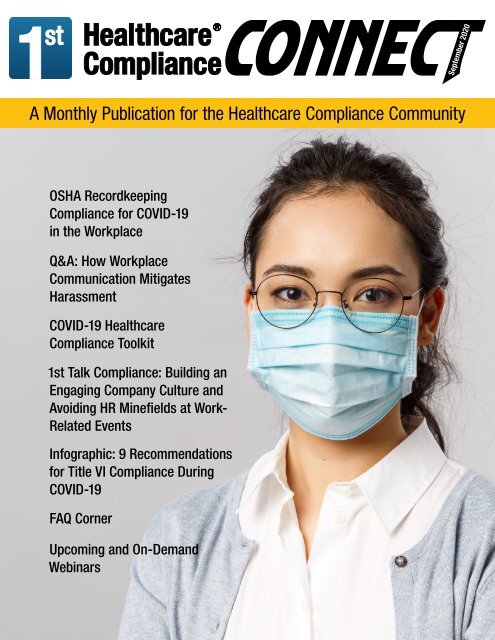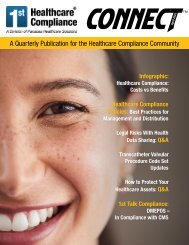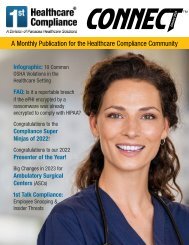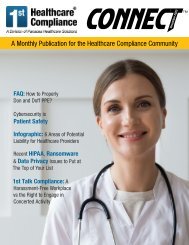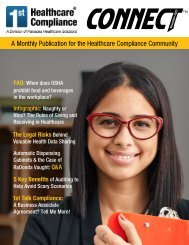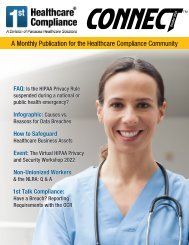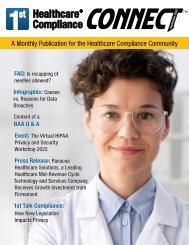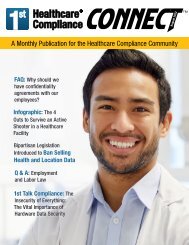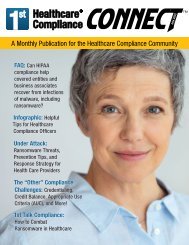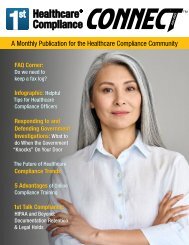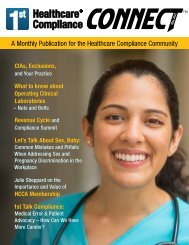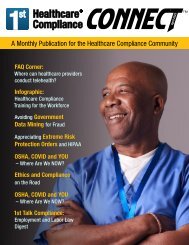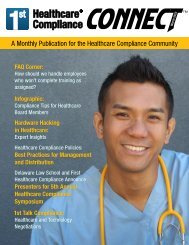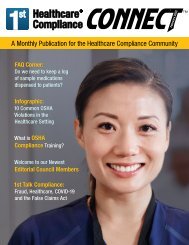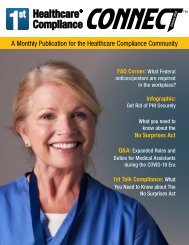First Healthcare Compliance CONNECT September 2020
You also want an ePaper? Increase the reach of your titles
YUMPU automatically turns print PDFs into web optimized ePapers that Google loves.
<strong>CONNECT</strong><br />
A Monthly Publication for the <strong>Healthcare</strong> <strong>Compliance</strong> Community<br />
<strong>September</strong> <strong>2020</strong><br />
OSHA Recordkeeping<br />
<strong>Compliance</strong> for COVID-19<br />
in the Workplace<br />
Q&A: How Workplace<br />
Communication Mitigates<br />
Harassment<br />
COVID-19 <strong>Healthcare</strong><br />
<strong>Compliance</strong> Toolkit<br />
1st Talk <strong>Compliance</strong>: Building an<br />
Engaging Company Culture and<br />
Avoiding HR Minefields at Work-<br />
Related Events<br />
Infographic: 9 Recommendations<br />
for Title VI <strong>Compliance</strong> During<br />
COVID-19<br />
FAQ Corner<br />
Upcoming and On-Demand<br />
Webinars
Got a Minute? Please Rate Us!<br />
The health of our company depends on the members<br />
of our community spreading the word about us.<br />
Share Your Success Story<br />
An endorsement by you is the greatest compliment we could receive! Please take a moment<br />
of your time to rate us online so that others can benefit from your experience. It’s a simple<br />
way to help us grow and improve.<br />
We appreciate your support and look forward to hearing from you!<br />
HIPAA PRIVACY<br />
AND SECURITY<br />
SUMMIT <strong>2020</strong><br />
NOVEMBER 12, <strong>2020</strong><br />
In This Issue:<br />
FAQ Corner<br />
OSHA Recordkeeping <strong>Compliance</strong> for COVID-19 in the Workplace<br />
Q&A: How Workplace Communication Mitigates Harassment<br />
2<br />
<strong>First</strong> <strong>Healthcare</strong> <strong>Compliance</strong>, LLC © <strong>2020</strong>
<strong>Compliance</strong> Super Ninja <br />
Julie Garcia, Business Office Manager<br />
Coastal Vascular Center<br />
How would you describe your<br />
experience with <strong>First</strong> <strong>Healthcare</strong><br />
<strong>Compliance</strong>?<br />
I find that 1st <strong>Healthcare</strong> <strong>Compliance</strong> is an easy<br />
and convenient way to stay on top of the ever<br />
changing compliance issues we face these days. I appreciate the regular emails,<br />
keeping me informed of upcoming meetings and also the fact that they meet the requirements<br />
for my annual CEUs needed to keep my certificate current.<br />
What do you enjoy most about working with Coastal Vascular Center?<br />
Coastal Vascular Center consists of three physicians and twelve employees. We have three office<br />
locations and yet the whole group works as a team. They all respond well to the compliance updates<br />
and changes. I am fortunate to have such a close knit, caring group of professionals to work with<br />
every day. May sound cheesy, but it is true!<br />
Would you rather give up your GPS or your movie streaming service?<br />
Hmmmmm ...GPS or movies streaming. I think I would rather give up my GPS and keep my movies.<br />
Many work days feel like we are on the road, GPS guiding, keeping us on track, even though we never<br />
leave our desks. It’s nice to get lost sometimes, especially in a good movie! I prefer the old classics,<br />
even though most were made before I was born.<br />
COVID-19 <strong>Healthcare</strong> <strong>Compliance</strong> Toolkit<br />
Infographic: 9 Recommendations for Title VI <strong>Compliance</strong> During COVID-19<br />
1st Talk <strong>Compliance</strong>: Building an Engaging Company Culture<br />
and Avoiding HR Minefields at Work-Related Events<br />
Upcoming and On-Demand Webinars<br />
Contact Toll Free: 888-54-FIRST 3
FAQ Corner<br />
Does a telemedicine visit count as an in-person visit to establish a<br />
serious health condition under the FMLA?<br />
On July 20, the U.S. Department of Labor (DOL) added the following guidance to its COVID-19<br />
related FAQs on the Family and Medical Leave Act (FMLA):<br />
Due to safety and health concerns related to COVID-19, many health care providers are treating<br />
patients for a variety of conditions, including those unrelated to COVID-19, via telemedicine.<br />
Telemedicine involves face-to-face examinations or treatment of patients by remote video conference<br />
via computers or mobile devices. Under these circumstances, will a telemedicine visit count as an<br />
in-person visit to establish a serious health condition under the FMLA?<br />
Yes. Until December 31, <strong>2020</strong>, the DOL will consider telemedicine visits to be in-person visits,<br />
and will consider electronic signatures to be signatures, for purposes of establishing a serious<br />
health condition under the FMLA. To be considered an in-person visit, the telemedicine visit must<br />
include an examination, evaluation, or treatment by a health care provider; be performed by video<br />
conference; and be permitted and accepted by state licensing authorities. This approach serves the<br />
public’s interest because health care facilities and clinicians around the nation are under advisories<br />
to prioritize urgent and emergency visits and procedures and to preserve staff personal protective<br />
equipment and patient-care supplies.<br />
For further information view the guidance here:<br />
https://www.dol.gov/agencies/whd/fmla/pandemic#q7<br />
Explore the FAQs tab in your compliance solution to find<br />
answers to your compliance questions!<br />
CLIENT<br />
ALERT<br />
4<br />
<strong>First</strong> <strong>Healthcare</strong> <strong>Compliance</strong>, LLC © <strong>2020</strong>
9 Recommendations for Title VI<br />
<strong>Compliance</strong> During COVID-19<br />
Title VI of the Civil Rights Act of 1964 protects people from discrimination based on race, color or<br />
national origin in programs or activities that receive Federal financial assistance. The Office of Civil<br />
Rights issued a bulletin providing the following nine recommendations for Title VI compliance during<br />
COVID-19 to healthcare providers that receive federal financial assistance.<br />
Adopt policies to prevent and<br />
address harassment and<br />
discrimination on the basis of<br />
race, color, or national origin<br />
Ensure that Community-Based<br />
Testing Sites and Alternate Care<br />
Sites are accessible to racial and<br />
ethnic minority populations<br />
Policies and procedures with<br />
respect to COVID-19 related<br />
services should not exclude<br />
or otherwise deny persons<br />
on the basis of race, color,<br />
or national origin<br />
1 2 3<br />
Individuals from racial and ethnic<br />
minority groups should not be<br />
subjected to excessive wait<br />
times, rejected for hospital<br />
admissions, or denied access to<br />
intensive care units compared to<br />
similarly situated non-minority<br />
individuals<br />
Provide ambulance service,<br />
non-emergency medical<br />
transportation, and home health<br />
services to all neighborhoods<br />
within the recipient's service<br />
area, without regard to race,<br />
color, or national origin<br />
4 5 6<br />
Select individuals to participate<br />
as members of a<br />
planning/advisory body which is<br />
an integral part of the recipient's<br />
program, without exclusions on<br />
the basis of race, color, or<br />
national origin<br />
Assign staff, including<br />
physicians, nurses, and<br />
volunteer caregivers, without<br />
regard to race, color, or national<br />
origin. Recipients should not<br />
honor a patient's request for a<br />
same-race physician, nurse, or<br />
volunteer caregiver<br />
Assign beds and rooms,<br />
without regard to race,<br />
color, or national origin<br />
7 8 9<br />
Make available to patients,<br />
beneficiaries, and customers<br />
information on how the recipient<br />
does not discriminate on the<br />
basis of race, color, or national<br />
origin in accordance with<br />
applicable laws and regulations<br />
Comprehensive <strong>Healthcare</strong> <strong>Compliance</strong><br />
Management Solutions<br />
CONFIDENCE INCLUDED<br />
Creating confidence among compliance<br />
professionals through education,<br />
resources, and support<br />
888.54.FIRST 1sthcc.com<br />
Contact Toll Free: 888-54-FIRST 5
OSHA Recordkeeping <strong>Compliance</strong><br />
for COVID-19 in the Workplace<br />
Sheba Vine, JD, CPCO<br />
Under the Occupational Safety and Health Administration<br />
(OSHA) recordkeeping regulations, employers are mandated<br />
to record serious occupational injuries and illnesses on the<br />
OSHA 300 Log. COVID-19 is a recordable illness if a worker is<br />
infected as a result of performing their work-related duties but<br />
how does an employer determine this? Given the nature of the<br />
COVID-19 pandemic and the difficulty in determining whether<br />
transmission of COVID-19 occurred in or outside the workplace,<br />
OSHA issued guidance to its <strong>Compliance</strong> Safety and Health<br />
Officers (CSHOs) in order to evaluate employers’ efforts in<br />
determining work relatedness of COVID-19 cases. The guidance<br />
clarifies employer obligations and provides a framework for<br />
employers to follow when facing a COVID-19 case in the<br />
workplace.<br />
When to Record and Report COVID-19 Cases<br />
Under OSHA’s regulations, employers must record a workrelated<br />
COVID-19 illness if all of the following apply:<br />
• The case is a confirmed case of COVID-19, as defined<br />
by the Centers for Disease Control and Prevention (CDC)<br />
(an individual with at least one respiratory specimen that<br />
tested positive for SARS-CoV-2, the virus that causes<br />
COVID-19);<br />
• The case is work-related as defined by 29 CFR § 1904.5<br />
(an event or exposure in the work environment either<br />
caused or contributed to the COVID-19 illness); and<br />
• The case involves one or more of the general recording<br />
criteria set forth in 29 CFR § 1904.7( if it results in any<br />
of the following: death, days away from work, restricted<br />
work or transfer to another job, medical treatment<br />
beyond first aid, loss of consciousness, involves a<br />
significant injury or illness diagnosed by a physician or<br />
other licensed health care professional).<br />
Note that there are two classes of employers that are partially<br />
exempt from OSHA’s recordkeeping requirements–employers<br />
with 10 or fewer employees and certain employers in low<br />
hazard industries (including physicians offices, dentists offices,<br />
other health practitioners offices, outpatient care centers,<br />
medical and diagnostic laboratories).<br />
All employers, including those partially exempt, must report the<br />
following severe injuries to OSHA:<br />
• report a COVID-19 illness that results in an in-patient<br />
hospitalization, amputation, or loss of an eye within<br />
twenty-four hours;<br />
• report COVID-19 fatality within eight hours.<br />
Determining if a COVID-19 Case is Work Related<br />
Once an employer has knowledge of a COVID-19 case, the<br />
employer is obligated to take the following steps to determine if<br />
it is a recordable work-related illness:<br />
Conduct a reasonable investigation into work-relatedness–<br />
OSHA’s guidance states that employers are not expected to<br />
undertake extensive medical inquiries, given employee privacy<br />
concerns. In conducting a reasonable investigation, in most<br />
cases it is sufficient for the employer to:<br />
6<br />
<strong>First</strong> <strong>Healthcare</strong> <strong>Compliance</strong>, LLC © <strong>2020</strong>
1. Ask the employee how he/she believes the COVID-19<br />
illness was contracted;<br />
2. Discuss the employee’s work and out-of-work<br />
activities that may have led to the COVID-19 illness,<br />
while respecting the employee’s privacy; and<br />
3. Review the employee’s work environment for potential<br />
SARS-CoV-2 exposure; the review should be informed<br />
by any other instances of workers in that environment<br />
contracting COVID-19 illness.<br />
Consider all evidence available to the employer– OSHA<br />
expects the employer to consider the evidence that a<br />
COVID-19 illness was work-related based on the information<br />
reasonably available to the employer at the time it made its<br />
work-relatedness determination. If the employer learns of<br />
additional information related to an employee’s COVID-19<br />
illness at a later date then that information should be taken<br />
into account as well.<br />
Consider evidence that a COVID-19 illness was contracted at<br />
work– In considering all the evidence, OSHA’s guidance states<br />
that certain types of evidence may weigh in favor of or against<br />
work-relatedness. Examples of evidence that weigh in favor of<br />
work-relatedness include:<br />
• several cases develop among workers who work<br />
closely together and there is no alternative explanation;<br />
If the employer cannot determine whether it is more likely<br />
than not that exposure in the workplace played a causal role<br />
with respect to a particular case of COVID-19, then according<br />
to the guidance, the employer does not need to record the<br />
COVID-19 illness.<br />
In conclusion, OSHA’s guidance serves as a valuable resource<br />
for employers and provides the framework for conducting a<br />
reasonable and good faith investigation in order to comply<br />
with regulations and more importantly to keep workers<br />
protected from an outbreak. Use of incident reporting and<br />
management software helps track and manage these types<br />
of compliance investigations with real-time visibility. <strong>First</strong><br />
<strong>Healthcare</strong> <strong>Compliance</strong>’s cloud based software solution<br />
offers these tools plus more when it comes to meeting your<br />
healthcare compliance needs. Visit our website to learn more<br />
about our comprehensive compliance management solution<br />
for healthcare providers and explore our blogs for informative<br />
articles.<br />
COVID-19 <strong>Healthcare</strong><br />
<strong>Compliance</strong> Updates<br />
• the illness is contracted shortly after lengthy, close<br />
exposure to a particular customer or coworker who<br />
has a confirmed case of COVID-19 and there is no<br />
alternative explanation; or<br />
• the employee’s job duties include having frequent, close<br />
exposure to the general public in a locality with ongoing<br />
community transmission and there is no alternative<br />
explanation.<br />
Evidence that weighs against work-relatedness include:<br />
• the employee is the only worker to contract COVID-19<br />
in his/her vicinity and the employee’s job duties don’t<br />
include frequent contact with the general public,<br />
regardless of the rate of community spread; or<br />
• the employee, outside the workplace, closely and<br />
frequently associates with someone (such as a family<br />
member, significant other, or close friend) who 1) has<br />
COVID-19; 2) is not a coworker, and 3) exposes the<br />
employee during the period in which the individual is<br />
likely infectious.<br />
In response to the global outbreak of the novel coronavirus<br />
disease (COVID-19), the Secretary of Health and Human<br />
Services declared a public health emergency on January 31,<br />
<strong>2020</strong>. Federal agencies have taken action by issuing updates<br />
and guidance to navigate the crisis. This ebook provides<br />
healthcare providers with important developments and<br />
resources that impact federal healthcare laws.<br />
Download Now<br />
Contact Toll Free: 888-54-FIRST 7
Q&A: How Workplace<br />
Communication Mitigates<br />
Harassment<br />
Catherine Short<br />
Warren Cook BS, MBA, MS, SHRM-certified of<br />
SymbianceHR, will be presenting the webinar How<br />
Workplace Communication Mitigates Harassment<br />
on <strong>September</strong> 22 at 12 pm ET. In anticipation of this<br />
webinar, Warren answered many commonly asked<br />
questions on our blog in relation to communication<br />
and harassment in the workplace:<br />
Why do you relate communication as a key<br />
problem to harassment in the workplace?<br />
The lack of respectful communication and appreciation<br />
for diversity of thought leads to behaviors that evolves<br />
into harassment. Without the development of respectful<br />
communication intent versus impact can be lost,<br />
providing others dignity and respect is absent and<br />
the establishment of trust is non-existent. When this<br />
communication breakdown happens, individuals will<br />
allow their biases to surface and influence how they<br />
interpret their environment and the reasons why things<br />
happen. As a result, they begin to communicate in a<br />
negative manner without respect for others which can<br />
often lead to comments and behaviors unacceptable in<br />
the workplace that manifest into harassing behavior.<br />
You touched the topic of inclusion during the<br />
presentation, I thought that had to do with<br />
diversity – can you clarify?<br />
Inclusion is often aligned with Diversity and is well<br />
recognized in recent years as a two-part process<br />
of establishing a more effective workplace. This is<br />
true however in the context of communication and<br />
harassment prevention, I believe that the improvement<br />
of communication in the workplace to include respect,<br />
dignity and diversity of thought requires people to be<br />
inclusive of other people’s ideas and contributions.<br />
The clarifying factor in this context is the inclusion<br />
has nothing to do with protected characteristics such<br />
as gender, race, national origin or sexual preference.<br />
Instead the inclusion is based on encouraging<br />
communication and engagement across functions,<br />
departments, units and teams to raise the level of<br />
engagement across the entire workforce. Training<br />
on this type of inclusion leads to civil and equitable<br />
treatment of all people outside the scope of diversity<br />
alone however still addresses the ability to mitigate the<br />
risk and liability of harassment in the workplace.<br />
Why do you believe leadership involvement<br />
is so important to mitigating harassment,<br />
employees often harass each other and not<br />
managers?<br />
The ability to model the behavior you expect from<br />
others is critical for a leader. To create followership<br />
and earn the respect from the workforce to follow<br />
the leader requires the leaders in the organization<br />
8<br />
<strong>First</strong> <strong>Healthcare</strong> <strong>Compliance</strong>, LLC © <strong>2020</strong>
to be visible, involved, and participate across the<br />
organization in the communication and engagement<br />
activities of the employees. By leader, I mean anyone<br />
in the organization with intrinsic or extrinsic authority<br />
to influence actions and behaviors hence impacting<br />
the culture. This expectation goes beyond just the<br />
C-Suite, it is every leader in the organization needs to<br />
understand their responsibility to model the appropriate<br />
behaviors and style of communication to respect others<br />
and build trust.<br />
Communication is important – how<br />
specifically could my business start to<br />
improve trust in the workplace?<br />
My advice is to start where you can apply some minor<br />
adjustments to have critical impact immediately.<br />
Therefore, train your supervisors and people leaders<br />
on how to engage their staff members during one-onone<br />
meetings to ask “What else could I be doing as<br />
your supervisor to help you be more successful in your<br />
role.” This question requires the supervisor to listen<br />
to the reply, be genuine and authentic in their desire<br />
to help their employees, and they must be willing to<br />
make changes in how they work to achieve success for<br />
both the employee and themselves. If the supervisor<br />
does this effectively, engagement improves, trust<br />
builds, performance and productivity will increase as<br />
will employee morale. This approach can produce a<br />
quick win while applying other strategies and practices<br />
to improve communication in the workplace that will<br />
ultimately reduce your risk and liability related to<br />
harassment.<br />
Warren is the president and co-founder of<br />
SymbianceHR as well as the Chief Talent Officer and<br />
cofounder of SymbianceHiRe and provides strategic<br />
oversight for service delivery, business operations, and<br />
technical guidance on consulting engagements. He is<br />
a human resources subject matter expert with over<br />
20 years of experience as a strategic business partner,<br />
project manager, and people leader across private and<br />
public sectors organizations.<br />
Be sure to register for Warren’s upcoming webinar<br />
on <strong>September</strong> 22nd How Workplace Communication<br />
Mitigates Harassment and check out our other HR<br />
resources, such as our online compliance training<br />
courses in the Basics of Family Medical Leave Act<br />
(FMLA) and Preventing and Addressing Workplace<br />
Harassment and Bullying. Plus, listen to our latest<br />
podcast with Warren. And check out Warren’s other<br />
blogs, Demonstrating the ROI of HR for your Business,<br />
Q&A: Got Diversity. Get Inclusion! and the Pending<br />
FLSA Changes, and webinars, Risk Management of<br />
Employment Practices, Got Diversity Get Inclusion and<br />
pending FLSA Changes, and Avoiding HR Issues at<br />
Company Events & Building an Engaging Culture, now<br />
on YouTube.<br />
Navigating Workplace Violence<br />
Prevention Under OSHA<br />
Workplace violence is a serious issue, especially in healthcare facilities. The<br />
Occupational Safety and Health Administration (OSHA) responded in 2015 by updating<br />
and publishing their guidelines on how to best prevent workplace violence. The OSHA<br />
workplace violence prevention guidelines help employees and employers alike by<br />
providing the necessary steps to maintain a safe work environment.<br />
DOWNLOAD NOW<br />
Contact Toll Free: 888-54-FIRST 9
COVID-19 <strong>Healthcare</strong><br />
<strong>Compliance</strong> Toolkit<br />
<strong>Healthcare</strong> compliance amidst COVID-19 presents new challenges for<br />
hospitals and healthcare providers. At top importance is the question of how<br />
to slow or stop the spread of COVID-19, while ensuring that your organization<br />
stays compliant.<br />
Now more than ever, your compliance department needs to have the necessary tools to help track, analyze,<br />
and respond to compliance challenges. To help navigate the process, we’ve gathered our best COVID-19<br />
resources below. If you need further assistance, please contact us here.<br />
VIEW TOOLKIT<br />
10<br />
<strong>First</strong> <strong>Healthcare</strong> <strong>Compliance</strong>, LLC © <strong>2020</strong>
The most comprehensive<br />
healthcare compliance course<br />
The Fundamentals is a user-friendly, four-module online course designed to help<br />
healthcare professionals understand the essential principles and practices of<br />
compliance.<br />
Written by our “dream team” of healthcare providers and attorneys, The<br />
Fundamentals course is packed with useful, easy-to-understand information that<br />
covers HIPAA, OSHA, employment law and enforcement of federal healthcare laws.<br />
The course takes less than four hours to complete, and the modules can be viewed<br />
in any order. A certificate of course completion is provided following successful<br />
completion of the online course and exam.<br />
The <strong>Compliance</strong> Certification Board (CCB)® has approved this event for up to 4.0<br />
nonlive CCB CEUs. Continuing Education Units are awarded based on individual<br />
attendance records. Granting of prior approval in no way constitutes endorsement<br />
by CCB of this event content or of the event sponsor.<br />
BUY COURSE NOW<br />
HIPAA Privacy and Security<br />
<strong>First</strong> <strong>Healthcare</strong> <strong>Compliance</strong> HIPAA Privacy and Security is a user-friendly<br />
resource designed to help healthcare, administrative, and compliance<br />
professionals, whether they serve as a covered entity or a business associate,<br />
better understand their compliance responsibilities under the Health Insurance<br />
Portability and Accountability Act. The book explains HIPAA privacy, security,<br />
enforcement and breach notification in plain language, and provides a<br />
comprehensive checklist that entities can use to get their compliance efforts<br />
off the ground.<br />
BUY BOOK NOW<br />
Contact Toll Free: 888-54-FIRST 11
hosted by Catherine Short<br />
Catherine Short speaks with Warren Cook President and Co-Founder of SymbianceHR on the topic<br />
of “Building an Engaging Company Culture and Avoiding HR Minefields at Work-Related Events.”<br />
Company culture is a factor that can lead to sustained success or unexpected failure. For this reason,<br />
leadership should pay special attention to the design, development, implementation and management<br />
of company culture to ensure it is sustainable and beneficial to the business. This episode will review<br />
the concept of business culture, explain the various constructs that form these standards, and provide<br />
strategies to improve workforce engagement to support the desired values for your business. We will also<br />
identify employment practice risks and liabilities when planning company-sponsored events to ensure you<br />
consider critical factors as you plan these inclusive events for your company.<br />
Listen weekdays at<br />
7:30am, 3:30pm, 11:30pm ET<br />
Check out our Show Page!<br />
Looking for the latest compliance insights?<br />
Subscribe to our feed and don’t miss a thing!<br />
12<br />
<strong>First</strong> <strong>Healthcare</strong> <strong>Compliance</strong>, LLC © <strong>2020</strong>
WORD SEARCH<br />
H I P A A E T X N S N A I C I S Y H P X<br />
A P R O F E S S I O N A L S J F W I Y K<br />
P I F H D J J I E M E R G E N C Y T Y U<br />
U W D F V O S I E B F Z Y N V X S N J E<br />
H C T N E M E G A N A M O I F M M U A F<br />
R W J K D C B F E C E R A C H T L A E H<br />
L N R O S H Z A K X D C H I J S H P Y F<br />
G U X P Q T N W C E O G N D O E C S Y F<br />
K D V R W E A J L N A D P E C C L V T V<br />
Y A J I W Z O N V U L D C M J U G C P W<br />
H R U V S D K E D G Y L F E F R U O K L<br />
T C P A I Q N A A A T F M L R I J M R E<br />
I P Y C I I G V N N R O D E W T E P W V<br />
P T W Y E R U T L U C D X T D Y A L R W<br />
J E N N C X Z B I C J W S F C C Z I T N<br />
H K T S B C V F K M H H P P Y D A A I Y<br />
E C I T C A R P R R M A J F C N N N S G<br />
G S Q G J J G J V E E U Q C P P R C D A<br />
T M U H Q Z Y E B X Y B S D A H T E F H<br />
A W Q C A J Z Z D L L T X L J R X I E Q<br />
COMPLIANCE HEALTHCARE PHYSICIANS<br />
TELEMEDICINE EMERGENCY CULTURE<br />
MANAGEMENT STANDARDS PROFESSIONALS<br />
HIPAA PRIVACY SECURITY<br />
SUMMIT CONVENIENT PRACTICE<br />
Contact Toll Free: 888-54-FIRST 13
Upcoming and On-Demand Webinars<br />
Training<br />
SEPT 22, <strong>2020</strong><br />
OCT 6, <strong>2020</strong><br />
OCT 20, <strong>2020</strong><br />
NOV 5, <strong>2020</strong><br />
ON DEMAND<br />
ON DEMAND<br />
How Workplace Communication Mitigates<br />
Harassment<br />
Why are Security & Governance for Health Data<br />
Analytics Vital?<br />
HIPAA: A Timely Overview & Update<br />
Vendor Management In <strong>Healthcare</strong>: The High Cost<br />
of Failing to Triage Your Vendors<br />
Federal <strong>Healthcare</strong> Fraud and Abuse Framework<br />
Diagnosis Coding: The Cost of One and Done<br />
Register<br />
Register<br />
Register<br />
Register<br />
All Upcoming Webinars<br />
All On Demand Webinars<br />
NEW FEATURES!<br />
Training Zone - New required training modules have been added titled “Fraud<br />
Waste and Abuse Training” and “General <strong>Compliance</strong> Training”. These modules replace the<br />
CMS training materials.<br />
Employee Zone - A Notes button has been added to the HepB Vaccination Status section.<br />
OSHA Zone - To assist with successfully completing your assessment embedded links to<br />
Resources have been added.<br />
New COVID-19 Resource section available from the dashboard for 1st Performance, 1st<br />
Professional, and 1st Premium.<br />
CLIENT<br />
ALERT<br />
Join us on Social Media!<br />
Contact our Client Services Team with your questions!<br />
888.54.FIRST or clientservices@1sthcc.com<br />
14<br />
<strong>First</strong> <strong>Healthcare</strong> <strong>Compliance</strong>, LLC © <strong>2020</strong>


